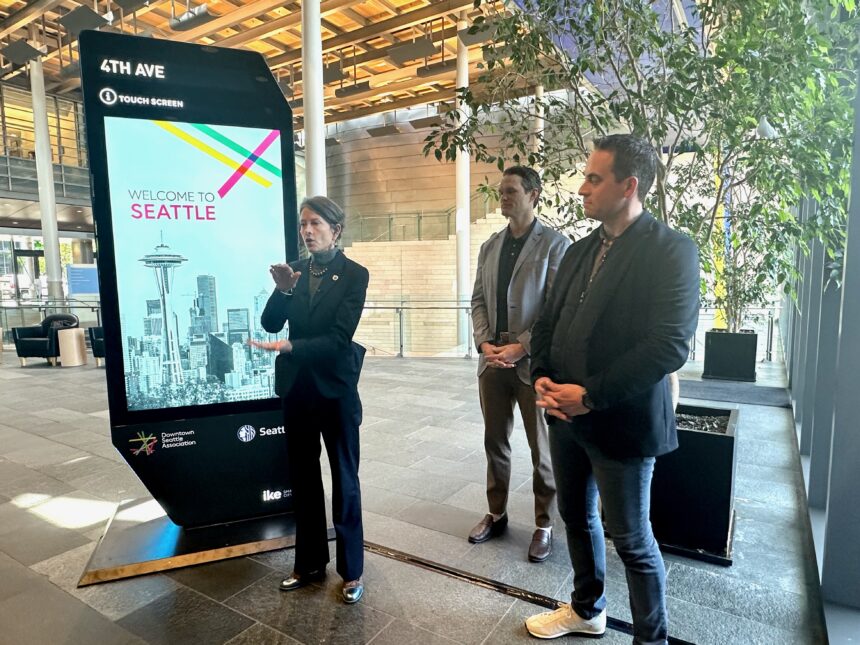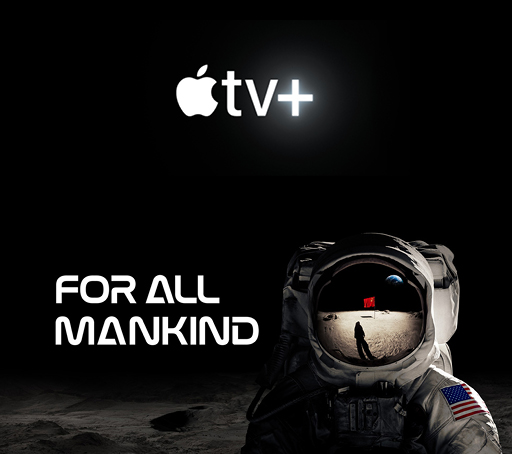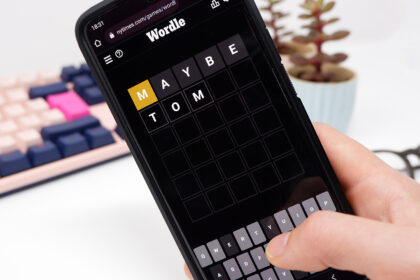Like a giant smartphone with content tailored to the needs of Seattle citizens and visitors, a large digital wayfinding kiosk was powered up at City Hall on Thursday to demonstrate the look and feel of infrastructure that could be coming to city streets.
The dual-sided, touchscreen kiosks feature Wi-Fi access and can relay information related to transportation, community events, safety, health, arts and entertainment, and more — with advertising included.
The desire to install the devices in the public right-of-way in the downtown core is in support of Mayor Bruce Harrell’s Downtown Activation Plan and the effort to revitalize the city post-pandemic.
“This is a proven tool in markets across the country,” said Jon Scholes, president and CEO of the Downtown Seattle Association (DSA), the organization that is serving as lead applicant and proponent to bring the kiosks to Seattle. “This will drive traffic and spending into our small business community, our neighborhood business districts, and increase attendance at arts and cultural events or concerts.”
The kiosks, called IKE Smart City, are a product of Columbus, Ohio-based advertising company Orange Barrel Media, which is partnering with DSA on the proposal. There are currently 23 U.S. cities where the digital kiosk program has been implemented, and the hope among stakeholders is to bring 30 of the devices to Seattle’s Metropolitan Improvement District in time for the FIFA World Cup in 2026.
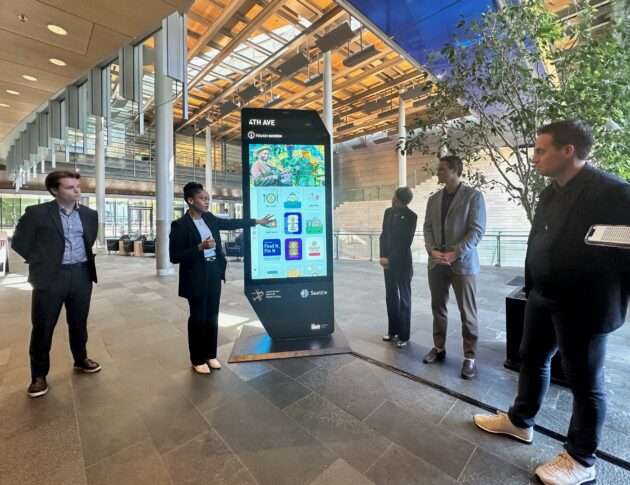
The Seattle City Council’s Governance, Accountability, and Economic Development Committee was meeting Thursday to discuss Resolution 32170, which would grant conceptual approval to DSA to install and operate the kiosks. The legislation is one step in the permitting process before a potential vote by the full Council in June.
Seattle City Council President Sara Nelson, who said she has been a strong backer of the project since her first day in office, cited the public benefits and the elevation of small businesses.
“This will generate revenue for our partner, DSA, for providing the essential services that improve the downtown area for everyone who works, lives and visits downtown,” Nelson said. “They provide trash pickup, graffiti removal, additional security — things that the city should do but doesn’t have the resources for.”
There is no cost to the City of Seattle for the installation or upkeep of the kiosks, which could generate, on average, $1.1 million per year via advertising revenue that would go to DSA. The organization says it would invest that money back into downtown. The City would also share in any additional revenue that exceeds an agreed-upon threshold.
Each IKE (interactive kiosk experience) measures just over 8 feet tall and 3 feet wide, with a depth of about 1 foot. The screen size is 12 1/2 square feet and can be interacted with like any smart touchscreen, with users scrolling through city-specific apps and content, such as maps, nearby restaurant listings, the city’s Find It, Fix It app, and more. There is also a button on the side of each kiosk which allows for 911 calls.
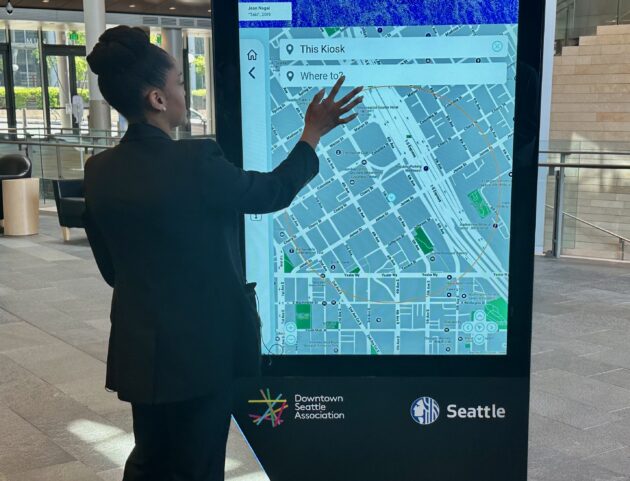
Clay Collett, senior development director for IKE Smart City, said the company is not trying to compete with anyone’s cell phone. The kiosks are intended to extend digital equity to people who might not have a smartphone or to engage tourists who might not know what to look for on their phones in a new city.
“What we want to do is be a compliment, and what we want to do is deliver a hyper-localized experience,” Collett said. “The content you’ll see in the city slide and in all of our applications is going to be curated by Seattle for Seattle, and promote local businesses.”
Scholes stressed that the kiosks are about “discovery,” whether someone lives in the area or is visiting.
“You don’t know what you don’t know,” he said. “It’s about helping understand what’s around me that I can take part in. And we don’t get to answer that just by having a phone.”
The kiosk screens, when in passive mode, cycle through eight slides that are a mixture of city content (25% of time) and advertising, which is used to monetize the whole concept. Some of the slides will feature local artwork.
When a user does tap into a kiosk screen, information on the screen will relate to what’s located nearby that kiosk.
In addition to the kiosks located in the downtown core, about 20 kiosks could be located in Business Improvement Areas in the city, such as the SoDo, Ballard, University District and West Seattle neighborhoods.
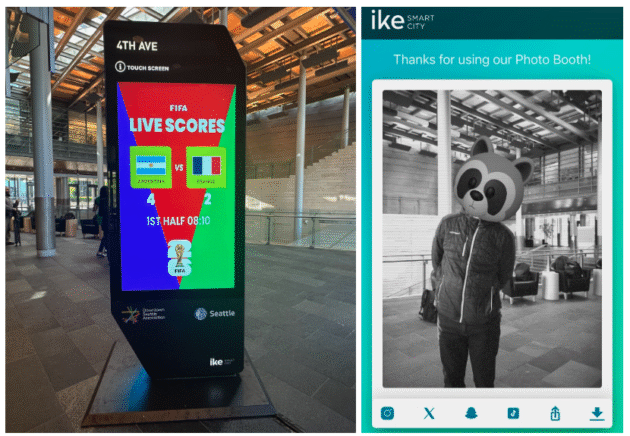
The kiosks will not include video cameras for surveillance. They do include a selfie camera that is part of a “Photo Booth” application, where users can interact and snap pictures to send to themselves. But IKE says photos are not stored on the kiosks or retained by the company.
Seattle’s IT department reviewed the IKE kiosk proposal and said it compiles with the city’s surveillance ordinance.
As for other privacy and data concerns, IKE says it does not collect or sell personally identifiable information or any other data, and the kiosks collect usage analytics data only. They record which applications are opened and for how long, and an anonymous tally is kept of user visits to each kiosk.
Collett said on average, kiosks in other cities are interacted with about 12 times each per day, or 440 times per month.
During a Seattle Design Commission meeting last year, some expressed concern about the visual clutter of the kiosks in the city’s landscape, oversaturation of advertising, and light pollution.
Scholes said that whenever a private thing is placed in the public realm, there should be a high standard, and there should be a series of public benefits for the Council to consider — whether it’s digital kiosks or scooters.
“You will have people that don’t like scooters, and there’ll be people that come in front of the Council that don’t like these,” Scholes said. “I think it’s up to our legislators to weigh the public benefits that are provided by this and what that means for locating it within the public realm.”
Read the full article here



